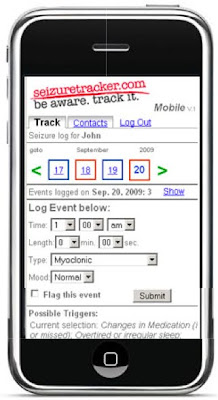 In order to objectively judge the efficacy of the ketogenic diet, we need to find a way to count Bertrand's seizures. This poses a BIG problem because he has several seizures (2 to 6) every minute, even in his sleep. That is close to 6,000 seizures (absence, complex partial with automatisms, drops, and startles) a DAY! (The number of XL spikes and XL events on his EEG are double to triple that, so I am glad I don't have to try and count those!)
In order to objectively judge the efficacy of the ketogenic diet, we need to find a way to count Bertrand's seizures. This poses a BIG problem because he has several seizures (2 to 6) every minute, even in his sleep. That is close to 6,000 seizures (absence, complex partial with automatisms, drops, and startles) a DAY! (The number of XL spikes and XL events on his EEG are double to triple that, so I am glad I don't have to try and count those!)
Knowing that, is there any wonder why he is so severely developmentally delayed? He can barely follow through on his impulses or commit anything to memory! When I try to count and log all of his seizures, I literally can't do anything else. By the time I'm done checking off the kind of seizure and writing down the duration, he's already had another one and I've missed it. It is very frustrating--but imagine how much worse it must be for Bertrand. :(
Furthermore, due to the nature of his seizures you have to be staring Bertrand in the face--you can't be across the room or sitting on a chair--you have to be on his level at all times. Every eye roll, head jerk, mouthing motion, and meaningless hand movement indicates that a seizure is occurring. I'd gladly stand a 24-hour vigil for B, except that someone has to play with him, feed him, change his diaper, get his books/toys, stroll him, (not to mention, use the restroom, cook, clean, etc.). Besides, it's not fair to seemingly ignore a baby even if it is for his own good.
So, I've been searching for seizure tracking resources. There are all kinds of spreadsheets and programs. One that I thought would be particularly useful is called SeizureTracker.com. Seizure Tracker is a free online program. You can print reports out from it and there is even a mobile version that works well on my iPhone (if AT&T's EDGE network isn't acting up). Furthermore, multiple parties (such as Mom and Dad) can be logged on to the same account thereby automatically syncing the seizure log! Seizure Tracker is fantastic if you've got at least a minute or two between seizures.
Unfortunately for Bertrand, Seizure Tracker proved too cumbersome in the handling of rapid succession seizures. The online nature of the program resulted in seconds wasted waiting for the page to refresh and the inability to log seizures when there was no internet connection (damn you, EDGE!). Also, for our purposes, it was too much of a good thing. There was no option to hide unnecessary values such as "Mood" or "Possible Triggers", which while I'll agree are important, can't be filled out while the next seizure is already occurring.
Simply having a downloadable, offline app of the program which syncs with the online version (for when the network is down) would be a huge improvement. Integrating the app with the iPhone's timer or the computer's built-in clock would also aide in working with rapid fire seizures. And, while I know it asking much of a free program, the ability to hide fields such as "Mood" and "Possible Triggers" would be helpful. However, if you have a child with a more traditional seizure disorder, these aspects may not be as vital, so Seizure Tracker will work great.
So, how am I going to solve Bertrand's seizure tracking issue? I've decided to track his seizures for one hour every day and extrapolate from it. That hour will be from 2PM - 3PM. This time is exactly in the middle of both Keppra doses, so the medication level in his blood should be fairly representative. This is also after his lunch and before his snack, so it should be a good time to observe Bertrand au natural. Using shorthand I'll log his seizures in a notebook, and adjust my logging system as needed. By tracking just this one hour a day we hope to see the effects of the ketogenic diet, and if we're successful with the diet, we can graduate to using Seizure Tracker!
.jpg)





.jpg)






